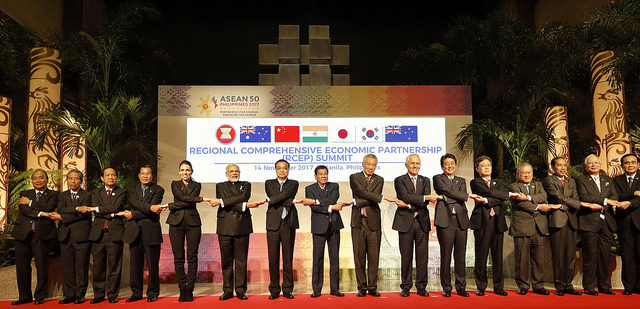Leaders of the 16 countries participating in the Regional Comprehensive Economic Partnership (RCEP) talks have reiterated their commitment to forge the deal and are hoping to see this happen by next year.
In a joint leaders’ statement issued at the first ever RCEP summit on November 14 in Manila, the heads of states of RCEP participating countries noted the breakthroughs achieved as a result of the increased engagement by ministers in the negotiations over the past year.
“While this negotiation continues to be a complex and challenging task, we reaffirmed our commitment to achieve a modern, comprehensive, high-quality and mutually beneficial economic partnership agreement negotiated as a single undertaking that would support an open and enabling trade and investment environment in the region,” the statement declared.
“We hereby instruct our Ministers and negotiators to intensify efforts in 2018 to bring the RCEP negotiations to conclusion, and resolve to ensure they have the necessary support to achieve this outcome,” it added.
The RCEP participants include the 10 Association of Southeast Asian Nations (ASEAN) member countries and ASEAN’s six free trade agreement (FTA) partners Australia, China, India, Japan, Korea, and New Zealand.
Together they account for almost half of the world population, 31.6% of global output, 28.5% of global trade, and a fifth of the global foreign direct investment inflows in 2016.
The statement reiterated the immense potential of RCEP to support job generation, drive sustainable growth, foster inclusive development, and promote innovation, which would ultimately improve the living standards of RCEP people.
To achieve this potential, RCEP will need to consolidate the ASEAN+1 FTAs and build new economic linkages between ASEAN’s FTA partners that do not have bilateral FTAs with each other, said the statement.
At the same time, RCEP should take into consideration the different levels of development of the participating countries, and include a provision for special and differential treatment, plus additional flexibility to the least-developed ASEAN member states.
Negotiations began in 2013 and member states had hoped to reach an agreement under the ASEAN chairmanship of the Philippines this year. However, disagreement among the six trading partners of ASEAN concerning key provisions in the RCEP prevented the conclusion of the mega trade deal as anticipated.
Economists were not surprised that the RCEP was not forged this year, but they are more optimistic that the ambitious pact will be completed in Singapore next year.
As of November 2017, the RCEP outline covers trade in goods; rules of origin; customs procedures and trade facilitation; sanitary and phytosanitary measures; standards, technical regulations and conformity assessment procedures; trade remedies; trade in services; financial services; telecommunications services; movement of natural persons; investment; and competition.
It also includes intellectual property, electronic commerce, small and medium enterprises, economic and technical cooperation, government procurement, and dispute settlement.
Photo courtesy of ASEAN Secretariat









